how to grow mushrooms uk
To the uninitiated but curious beginner, the idea on how to grow mushrooms uk can be a complete mystery. What is this eccentric, underground science I hear, you ask?
Well, here is the truth. Growing mushrooms is a lot more straight forward than you might think. And doing so has a whole host of incredible benefits.
As a wise man once said:
“Give a man a mushroom and you feed him for a day; teach a man to grow them and you feed him for a lifetime”.
A single post could never do the topic justice, but hopefully, this article provides a basic outline for people who want to learn more about these fascinating organisms.
What Are Mushrooms?
Mushrooms, the general name given to the kingdom of life known as fungi, are truly alien. The famous ethnobotanist, psychonaut and philosopher Terrence McKenna once theorised:
“The mushroom is a good candidate for an extra-terrestrial… a curious combination of artefact and entity”.
You see, we didn’t call our company Martian Mushrooms for nothing!
Whilst mushrooms might appear alien to us, humans are more closely related to fungi than any other kingdom, including plants. This means that fungi are actually our long, long distant ancestors. Weird right? You could even say that fungi are our brothers from another mother. Or perhaps our brothers from another great, great, great, great… well you get the point.
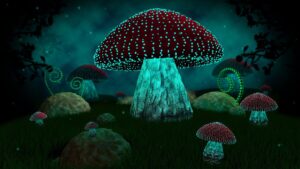
Did mushrooms come from space?
The Mushroom Life Cycle (how to grow mushrooms uk)
Their extra-terrestrial nature aside, what exactly is a mushroom? To make things a little stranger, mushrooms are the reproductive organ produced by some species of fungi. The typical mushroom, comprised of the cap and stem, does look quite phallic in appearance. Ever heard of Penis Envy mushrooms? Yes, that’s a real thing
Their striking resemblance shouldn’t be a surprise, because they are both phallic in appearance and nature. In more technical terms, mushrooms are the fruiting bodies produced by certain fungus during the final stage of their reproductive life cycle. To understand this a bit better, let’s head back into the classroom and have a look at a diagram.
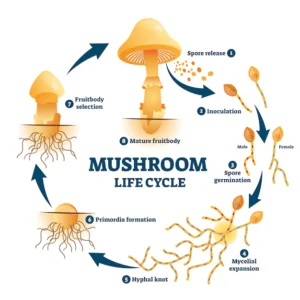
You can see from the above that there are essentially 4 stages to the mushroom life cycle.
-
The mushroom itself, also called the fruiting body.
-
The spores produced from the mushroom.
-
Spore germination in the right environment.
-
Mycelium, from which mushrooms are produced. The cycle repeats.
Click Here To Buy Mushroom Growing Kits In UK
So, we already know that a mushroom is the reproductive organ of a fungus. From the fruitbody, spores are produced, which are a bit like plant seeds. They contain all the genetic material needed to produce a new generation of fungi.
Mushrooms usually occur for just a few days and release billions of spores. These spores, if they are lucky enough to find itself in a nutrient rich environment and the conditions are just right, it will germinate.
The majority of the fungal life cycle takes place hidden in the subterranean, in soil, logs and other organic matter. Here, the fungus is made up of a fine threadlike network called mycelium. You can think of mycelium as the roots that provide nutrients to the fungus to help it develop the fruiting body.
This mycelium root system releases enzymes or ‘digestive juices’ that decompose organic material to its constituent nutrient compounds, which it can then absorb to fuel further growth and expansion. how to grow mushrooms
If learning about digestive juices gets you going, you can learn more about the mushroom life cycle in another article.
Whilst we’re on the topic, here’s an interesting fact. The largest organism on earth is a fungal network of mycelium. A species of fungi called Armillaria ostoyae, or the honey mushroom, has a mycelial network that spans over 2,384 acres. This is the equivalent to 1,665 football fields!
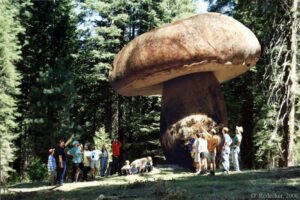
It was discovered in Oregon’s Blue Mountains, with scientists estimating it to be between 2,400 and 8,650 years old, which would earn it a place among the oldest living organisms as well. Pretty fly for a fungi!
Ok, so this isn’t a real mushroom. We wish it was. However, the mycelium root system of a honey fungus in Oregan is roughly the size of 1,665 football fields!
The Ingredients on how to grow mushrooms uk
As a cultivator of how to grow mushrooms, it is critical to understand their life cycle. By knowing how they grow, our primary goal should be to cultivate and nurture fungal mycelium.
This is the part of the fungus that produces our beloved mushrooms, so we need to look after it well and keep it happy. If you can learn to do that effectively, then rest assured you will grow plenty of ‘shrooms.
Before discussing in more detail the various methods of cultivation, let’s briefly touch on what conditions and requirements are needed for growing mushrooms at home. how to grow mushrooms indoors
1. Mycelium (how to grow mushrooms on logs)
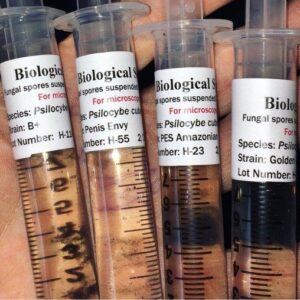
To start in your new venture, you’ll need to get your hands on some mycelium. There are a few options here.
Most people opt to start with a spore syringe, which can be germinated to produce mycelium. Alternatively, a liquid culture syringe can be used which already contains pre-germinated spores, in the form of a liquid mycelium mixture.
Spore syringes are a popular choice for beginners. Inside the tubes are millions and millions of spores.
Whichever you choose, spores and liquid culture syringes are easy to use and readily available to purchase.
Mycelium can also be procured in the form colonised petri-dish or as fully colonised mushroom spawn.
Mushroom spawn consists of sterilised grains (a mushroom substrate) that have been colonised by mycelium. Making grain spawn properly requires more advanced growing techniques, so we don’t recommend going this route for a beginner. However, grain spawn is readily available from reputable vendors.
A mycelium culture growing out on an agar dish. A work of mycelial art.
2. Mushroom food (how to grow mushrooms in the garden)
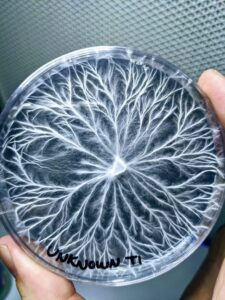
In order to how to grow mushrooms uk, we need to provide the growing mycelium with a highly nutritious food source. We call this substrate.
The food source we choose will depend on the mushroom species we want to cultivate, but the most common substrates are grains, coffee, manure, straw or hardwood sawdust. This substrate will provide all the nutrients for the mycelium to grow and eventually produce mushrooms.
Substrate will usually be bagged, put into a container, jar or similar vessel. Depending on the conditions of where you live, mushrooms can also be grown on outdoor logs or indoor/outdoor beds.
A selection of substrate types on the mushroom menu.- how to grow mushrooms uk
3. Sterilisation (how to grow edible mushrooms at home )
Once a substrate is selected, it is either pasteurised or sterilised using a variety of techniques.
Why is this necessary I hear you ask? (how to grow mushroom uk)
As already mentioned, mushrooms require a sterilised substrate in order to grow. In layman’s terms, this just means some organic material that the mushrooms ‘eats’ to get the carbon and nitrogen it needs for growth. In the wild, a mushroom shares its food or ‘substrate’ with many other organisms, primarily bacteria and other fungi. However, these are unwelcome dinner guests when we’re trying to cultivate our desired mushrooms at home. Bacterial or fungal contaminants that have hijacked your grow can produce toxins that make you ill, so it’s something you must try and avoid. how to grow mushrooms
The mean green, a name affectionately given to Trichoderma mold, strikes again!
However, herein lies the eternal struggle for how to grow mushrooms uk– the battle to keep these contaminants at bay. In order to grow mushrooms, we also create the ideal conditions for other unwanted fungi and bacteria to grow. Which they certainly will do if left unchecked! To tackle this problem, the substrate we use MUST be sterilised. In short this means blasting it with a high heat and high pressure for at least an hour to kill off any contaminants. Some less nutrient dense substrates, like coco coir, can be pasteurised rather than sterilised. This basically means the substrate is heated (but not at very high temperature as with sterilisation) to kill off most of the bad stuff we don’t want to be growing.
This might also sound a bit complicated, but don’t worry. Premade substrate that has already undergone the sterilisation/pasteurisation process is readily
Once the substrate is ready, we need to add a sample of clean and healthy spores or mycelium to grow out on.
The process is called the inoculation of a substrate. The mycelium will then grow out and consume the substrate, in a process called colonisation.
Some healthy mushroom mycelium chewing through some substrate.
The Growing Conditions on how to grow mushrooms uk
In addition to supplying the mycelium with food, we also need to simulate the optimal conditions of its natural habitat. Fungi, like any other living organism, need a constant supply of food, water and air. When growing mushrooms, we essentially mimic the same life cycle and conditions that fungi go through in the wild.
Creating the right conditions signals the mycelium to produce fruiting bodies or how to grow mushrooms uk. This process is called fruiting. Depending on the species that are being grown, some may have relaxed growing conditions and will fruit very easily.
On the other hand, some species are far more particular and require special growing conditions at certain phases of growth to see results.
The essential growing conditions that must be fulfilled on how to grow mushrooms uk are as follows:
-
Humidity (water)
-
Air exchange (O2/CO2)
-
Temperature
-
Light
1. Humidity
Mushrooms are made up of around 90% water, so they like a LOT of humidity. Whilst they grow they should be placed away from strong drafts that could dry them out. Most growers will also invest in a spray bottle and mist their mushrooms multiple times daily. learn how to grow mushrooms
2. Air Exchange
Once fully colonised, we need to introduce fresh air and plenty of humidity to induce the formation of mushroom pins and subsequent fruiting. During colonisation (the expansion of mycelium), higher CO2 environments are preferable. However, when it comes to fruiting, more O2 is required to develop the mushrooms.
3. Temperature
During the colonisation phase, where the mycelium expands rapidly to devour its substrate, it needs to incubate at a relatively warm temperature. The ideal range lies between 21-26°C. For fruiting, temperatures can be lowered by a few degrees.
4. Light
Many beginners think that how to grow mushrooms uk need to grow in the dark. Whilst it is somewhat true, some ambient (low-level) light is also required for the final stage of the mushroom life cycle. how to grow mushrooms inside
In fact, light is a key pinning trigger, a cue to the mycelium that it can begin to form a mushroom fruit body.
In most cases, there is no need to invest in fancy lighting equipment. Light ambient from a window is perfectly suitable for normal mushroom growth. Alternatively, a basic room light will do the job.
